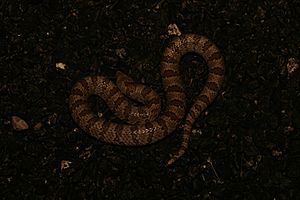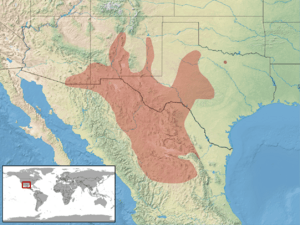Western hooknose snake facts for kids
Quick facts for kids Gyalopion canum |
|
|---|---|
 |
|
| Conservation status | |
| Scientific classification | |
| Genus: |
Gyalopion
|
| Species: |
canum
|
 |
|
| Synonyms | |
|
|
The Western hooknose snake, also known as Gyalopion canum, is a small snake. It lives only in the deserts of the United States and Mexico. People sometimes call it the Chihuahuan hook-nosed snake because it is often found in the Chihuahuan Desert.
Contents
About the Western Hooknose Snake
This snake is a type of colubrid snake. It is known for its unique snout that looks like a hook. This special nose helps it dig in the sand.
What's in a Name?
The Western hooknose snake got its first scientific name, Gyalopion canum, in 1860. This name was given by a scientist named Edward Drinker Cope. Later, in 1883, another scientist, Samuel Garman, changed its name to Ficimia cana.
However, in 1985, a scientist named Robert C. Stebbins changed it back to Gyalopion canum. This was because the snake had special body features that matched the Gyalopion group better.
Where Does It Live?
You can find Gyalopion canum in the western parts of the United States. This includes areas from western Texas to southeastern Arizona. It also lives in northern and central parts of Mexico.
What Does It Look Like?
The Western hooknose snake is a small snake. It usually grows to about 36.5 centimeters (about 14 inches) long. This measurement includes its tail.
Its body is gray or grayish-brown. It has 25 to 48 dark brown or black spots along its back. The underside of its body is a creamy white color. Its nose is slightly turned up, which is why it's called a "hooknose" snake.
The scales on its back are smooth. They are arranged in 17 rows around the middle of its body.
Snake Behavior and Habitat
The Western hooknose snake is a nocturnal animal. This means it is active mostly at night. During the day, it likes to burrow underground or hide under rocks.
Where It Likes to Live
This snake prefers places with a bit of sand. It also likes to be near a constant source of water. This helps it stay hydrated in the desert.
What It Eats
The Western hooknose snake mainly eats spiders and centipedes. But it will also eat small snakes and even scorpions if it finds them.
Reproduction
The Western hooknose snake lays eggs. This means it is an oviparous animal. Female snakes that are old enough to have babies can lay up to 5 eggs in June.
How It Defends Itself
One interesting way this snake defends itself is by making a popping sound. It does this with its cloaca, which is an opening at the end of its body. This sound can surprise predators.
How Fast Is It?
While not known for long-distance speed, Gyalopion canum can move very quickly in short bursts. This helps it escape danger or catch prey.


